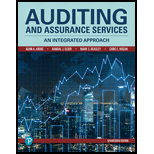
Auditing And Assurance Services
17th Edition
ISBN: 9780134897431
Author: ARENS, Alvin A.
Publisher: PEARSON
expand_more
expand_more
format_list_bulleted
Question
Chapter 5, Problem 10RQ
To determine
Differentiate among the auditor’s potential liability to the client, liability to third parties under common law, civil liability under the securities laws, and criminal liability. State one situation for each type of liability in which the auditor can be held legally responsible.
Expert Solution & Answer
Want to see the full answer?
Check out a sample textbook solution
Students have asked these similar questions
Eddie Corporation issues $1,700,000 of 9% bonds at 103. What is the amount of cash Eddie would receive from the sale?
Compute the company's predetermined overhead rate
Which inventory costing method is prohibited under IFRS? a) FIFO b) Weighted average c) LIFO d) Specific identification MCQ
Chapter 5 Solutions
Auditing And Assurance Services
Ch. 5 - Prob. 1RQCh. 5 - Prob. 2RQCh. 5 - Prob. 3RQCh. 5 - Prob. 4RQCh. 5 - Prob. 5RQCh. 5 - Prob. 6RQCh. 5 - Prob. 7RQCh. 5 - Prob. 8RQCh. 5 - Prob. 9RQCh. 5 - Prob. 10RQ
Ch. 5 - What potential sanctions does the SEC have against...Ch. 5 - Prob. 12RQCh. 5 - Prob. 13RQCh. 5 - Prob. 14.1MCQCh. 5 - Prob. 14.2MCQCh. 5 - Prob. 14.3MCQCh. 5 - Prob. 15.1MCQCh. 5 - Prob. 15.2MCQCh. 5 - Prob. 15.3MCQCh. 5 - Prob. 16.1MCQCh. 5 - Prob. 16.2MCQCh. 5 - Prob. 16.3MCQCh. 5 - Prob. 17DQPCh. 5 - Prob. 18DQPCh. 5 - Prob. 19DQPCh. 5 - Prob. 20DQPCh. 5 - Prob. 21DQPCh. 5 - Prob. 22DQPCh. 5 - Prob. 23DQPCh. 5 - Prob. 24DQPCh. 5 - Prob. 27DQPCh. 5 - Prob. 28C
Knowledge Booster
Similar questions
arrow_back_ios
SEE MORE QUESTIONS
arrow_forward_ios
Recommended textbooks for you
 Auditing: A Risk Based-Approach (MindTap Course L...AccountingISBN:9781337619455Author:Karla M Johnstone, Audrey A. Gramling, Larry E. RittenbergPublisher:Cengage LearningBusiness Its Legal Ethical & Global EnvironmentAccountingISBN:9781305224414Author:JENNINGSPublisher:Cengage
Auditing: A Risk Based-Approach (MindTap Course L...AccountingISBN:9781337619455Author:Karla M Johnstone, Audrey A. Gramling, Larry E. RittenbergPublisher:Cengage LearningBusiness Its Legal Ethical & Global EnvironmentAccountingISBN:9781305224414Author:JENNINGSPublisher:Cengage Auditing: A Risk Based-Approach to Conducting a Q...AccountingISBN:9781305080577Author:Karla M Johnstone, Audrey A. Gramling, Larry E. RittenbergPublisher:South-Western College Pub
Auditing: A Risk Based-Approach to Conducting a Q...AccountingISBN:9781305080577Author:Karla M Johnstone, Audrey A. Gramling, Larry E. RittenbergPublisher:South-Western College Pub

Auditing: A Risk Based-Approach (MindTap Course L...
Accounting
ISBN:9781337619455
Author:Karla M Johnstone, Audrey A. Gramling, Larry E. Rittenberg
Publisher:Cengage Learning


Business Its Legal Ethical & Global Environment
Accounting
ISBN:9781305224414
Author:JENNINGS
Publisher:Cengage

Auditing: A Risk Based-Approach to Conducting a Q...
Accounting
ISBN:9781305080577
Author:Karla M Johnstone, Audrey A. Gramling, Larry E. Rittenberg
Publisher:South-Western College Pub